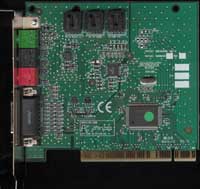Future Power - Power Series P3-500
by Anand Lal Shimpi on October 3, 1999 12:13 AM EST- Posted in
- Systems
Audio
The audio subsystem of the computer was driven by the Creative Labs Ensoniq 1373, also known as the AudioPCI. As the name implies, this is a PCI sound card (it's a real card, not software driven) and is a very cost effective one at that. The sound produced by the card is equivalent to that of a Sound Blaster 64 and it is compatible with the Sound Blaster standard. The card is a 2D only solution, meaning it offers no support for 3D sound APIs which is a bit of a disappointment if you're a gamer considering this system. However, since the system isn't targeted at gamers, you can't complain too much.
With the Sound Blaster Live! Value selling at below $100, it would have been nice to have the four speaker output of the Live! but it seems like cost was the bottom line here, and thus the 1373 was the chosen one.
The two speaker output of the 1373 is taken advantage of by the bundled Altec Lansing ACS21W speaker set. The set comes with two speakers and no sub woofer. The satellites each feature a 3" driver which get 2.5 Watts of power per satellite for a total of 5 Watts of power (RMS). The satellites can handle frequencies from 110Hz to 18kHz, which is about average for a set of speakers of this class.
The two satellites are attached to each other by an integrated (non-removable) stereo cable and the right speaker has the standard 1/8" plug for your soundcard. The power adapter is integrated into the speaker itself, requiring that only a power cable be present outside of the speakers, which helps remove some of the clunky clutter normally found around a computer.
The speakers produce decent sound but, the speakers themselves don't get too incredibly loud and have a tendency to distort at higher volumes, especially during gameplay. While watching DVD movies, the speakers do seem to produce high quality output that is fairly crisp, although, naturally, we've heard better from more expensive speakers.
While we mentioned that cost as most likely the determining factor behind the decision to use the 1373 as the driving force behind the Power Series' audio subsystem, what we didn't mention was that the 1373 isn't the sole output device. The system features Future Power's own NEWQ Gold graphic equalizer/stereo amplifier that sits comfortably in the top most 5.25" drive bay.

In addition to the basic functions as an equalizer, including preset styles such as Normal, Pop, Rock & Classic, the NEWQ Gold functions as a stereo amplifier. This helps offset the weak Altec Lansing speakers we just finished discussing. The volume of the amplifier is controlled by the larger knob on the NEWQ Gold's faceplate and a volume indicator is present on the VFD (Vacuum Fluorescent Display) also located on the faceplate. Unfortunately if you crank up the amp beyond the first few degrees using the volume control on the NEWQ Gold, the speakers begin distorting. The NEWQ Gold was a nice idea, but it was a poor idea to pair it up with the ACS21Ws.
For movie buffs, the NEWQ Gold comes in handy because it features three surround sound modes that help heighten the impact of the sound on you, especially during DVD playback. Other than the normal mode setting (no 3D audio), the NEWQ Gold allows you to enable SRS Surround Sound and its TruSurround function. While the latter two settings do very little for gameplay, the TruSurround option does make for a much better audio experience when playing back DVD movies. It was impressive what those two speakers could do once placed in TruSurround mode while watching a movie.
Finally, the NEWQ Gold's faceplate features microphone and auxiliary input/output jacks as well as a single touch mute button and an equalizer control button.
Although the NEWQ Gold was a cool looking addition, chances are that it isn't an option you'll miss if it wasn't there. We would have much rather for the option of a SB Live! or a Aureal Vortex 2 based card instead of the ES1373 + NEWQ Gold setup, which is obviously more expensive than either of those two. The NEWQ Gold is more of a luxury feature, but until the rest of the system is perfect, there is no point to go after adding luxury features to it. A better sound card and better speakers would be required for the audio subsystem to gain our approval.











0 Comments
View All Comments